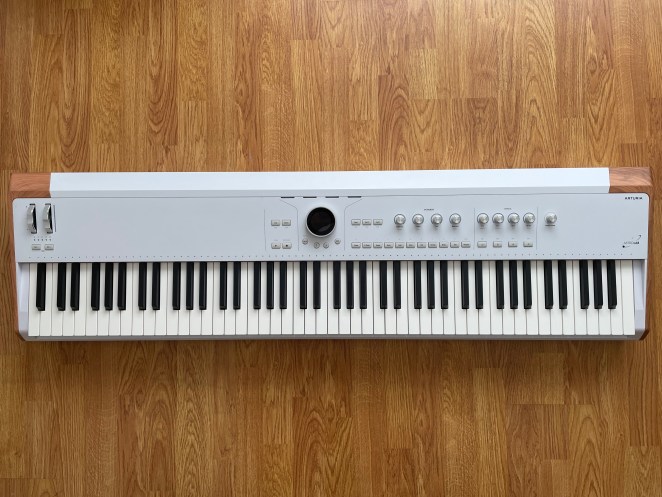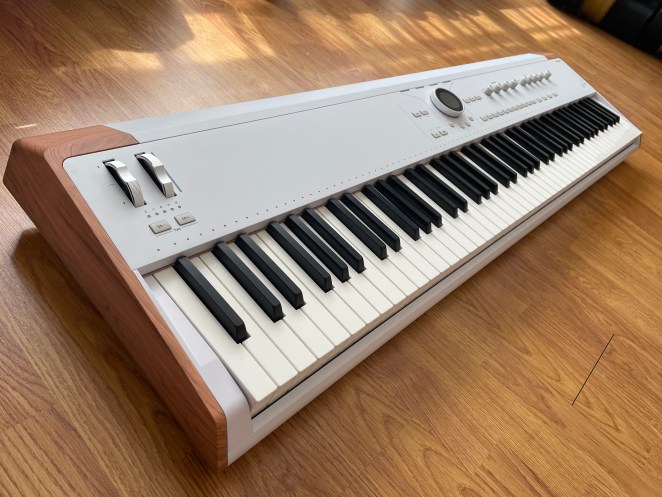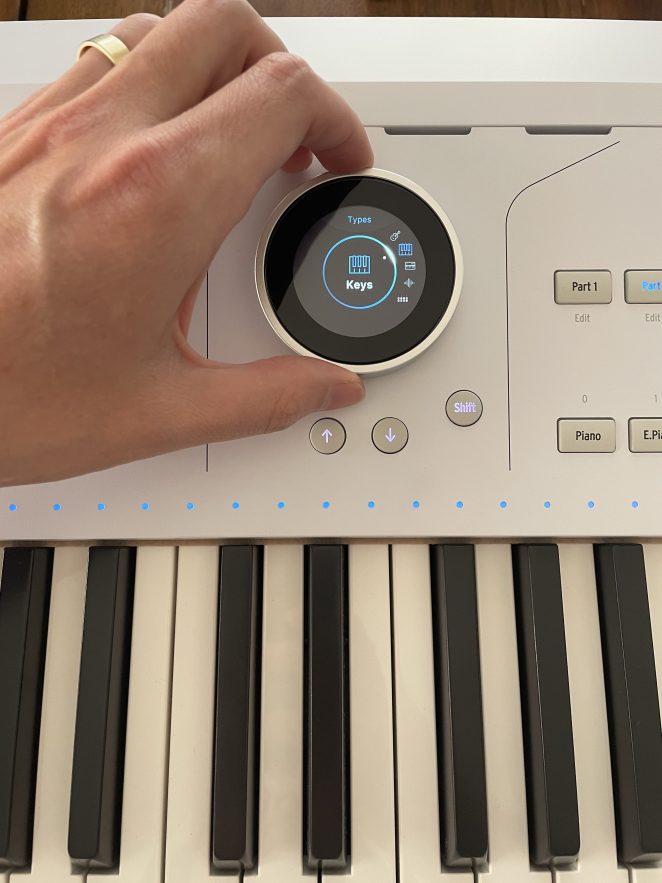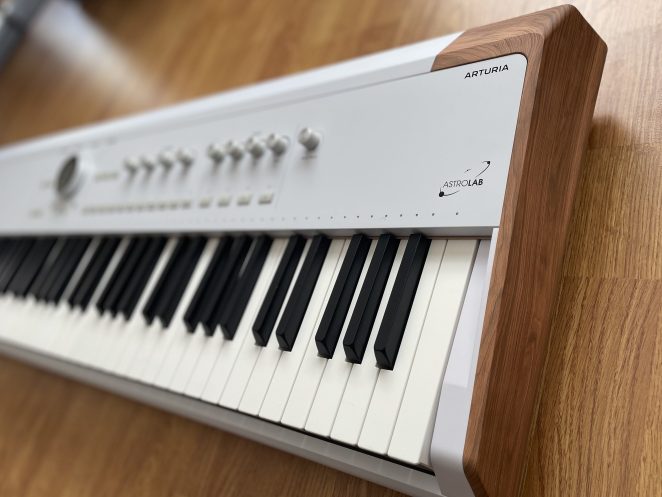Sponsored Post
Avant-garde: an intelligentsia that develops new or experimental concepts, especially in the arts.
Arturia’s AstroLab series represents the latest tech in their 25+ year history of creating “Avant-garde” stage keyboards. Part MIDI controller, part stage piano, the 61-key AstroLab is already celebrated as one of the best stage keyboards at its price point, and now Arturia has blessed us with an 88-key version that brings many of the same features as the 61-key—and then some.
With 30+ instruments, and over 1,300 built-in sounds, Arturia touts the AstroLab as “the first instrument that truly delivers on the promise of software instruments embedded in hardware.” So, does it? Let’s dive in and find out.
Unboxing and Overview
My first impression upon unboxing was that this thing looks just absolutely stunning. Which is a big deal to me, because my wife won’t allow just any keyboard to sit out in the living room! It’s a really clean design, with a matte white and faux-wood finish that’s definitely not your average synth’s design aesthetic. I love retro and vintage design, and have acoustic guitars lying around everywhere, so I find its looks pretty appealing.

But that’s not to say it necessarily looks vintage or retro at all—maybe retro-futuristic? Arturia’s got a whole aesthetic brand that is sort of Star Wars, space-retro, very stylish and cool, and, dare I say, European? The design goes beyond mere aesthetics into a philosophy that values ease of use just as much as looks, and integrates the two seamlessly.
Thought experiment: where most other keyboards are PCs—not all that user-friendly, not all that cool-looking, not super inspiring—an Arturia would be a Mac. It’s a work of art in its own right. You can tell they put a lot of thought into their visual identity and user experience that creates a strong sense of brand, and has definitely created a cult following—and, honestly, I get it. This thing is just plain cool.
What is the Arturia AstroLab 88?
KEY SPECS
- 30+ Instruments
- 1300+ Sounds (up to 10,000 with companion software integration)
- Keys: 88 Semi-weighed (Fatar TP-40 Hammer Action)
- Connectivity: MIDI, Bluetooth, USB, Expression, Sustain, auxiliary input, XLR/TRS Combo, ¼” Headphone out
Arturia describes the AstroLab as “a hardware version of (their) Analog Lab software, which in turn gathers a plethora of Presets from all of the more than 30 instruments across (their) renowned V Collection anthology of the most desirable vintage synthesizers and keyboards in the world.”
That means AstroLab grants you access to the greatest hits of Arturia’s sound catalog, all pre-loaded into the hardware. But you can also load your own presets from Analog Lab (included), allowing you a seamless transition from the studio to the stage.
Forget about bringing your laptop with you to the gig, and all the frustration that goes with it—the Astrolab is the first keyboard of its kind in that it combines the versatility of a studio synth with the convenience and portability of a stage keyboard. A whole new revolutionary concept of what a stage keyboard can be, AstroLab allows you access to an incredibly comprehensive (and flexible) library of sounds, packed into an intuitive, attractive interface that allows you to virtually bring the studio to the stage.

And with 88 Fatar TP-40 hammer-action keys, the new AstroLab 88 is Arturia’s best piano yet, with a feel that splits the difference between a traditional synth and a piano, so all players will feel equally at home.
AstroLab employs novel controls as well, including a navigation wheel with an integrated screen that lends a contemporary edge to the interface that feels very fresh. We have these kinds of things in our homes already (it kind of resembles a Nest), but in musical instrument tech, not so much—user interfaces can often feel stuck in the ‘80s despite the instruments containing cutting-edge tech within. I, for one, love the wheel/screen—I feel like I’ve got a keyboard straight out of 2001: A Space Odyssey.
Layout and Controls
The layout design is super clean as well. I was so happy when I saw how simple the interface was. I’m primarily a guitarist, I play keyboards and love them but I am far from a modular synth whiz—I need my keyboards to be easy to use. And you’d think this thing was designed by Steve Jobs for how clean and easy to use the controls are.
The first thing that caught my attention (and, I’m sure, yours as well) was the navigation wheel, which encompasses a screen on which you navigate the menu by scrolling the wheel around. The color screen is super impressive, with very attractive graphics that lend the user experience a really nice premium touch. It’s a really novel design that makes a ton of sense and really preserves space on the face of the keyboard, which is essential to the interface not feeling cluttered—essential for performing live.
There’s also a simple set of switches that allow you to easily dial in different instruments on the fly, as well as adjusting their timbre, brightness, and more via the instrument knobs. There’s a set of knobs for effects as well, with controls for intensity, reverb, and delay right there so you don’t have to dive into a menu while you’re in the middle of something. And, of course, pitch bend and modulation wheels, as well as octave controls.

Presets and Sounds
To complement its simplicity of design, the AstroLab is all about the presets—which means it’s super easy to get the sounds you want. And, simply put, the Artists presets have what I personally want (Beatles Tribute, Doors Tribute, Zeppelin Tribute..!). But there’s way more than just classic rock where that came from—obviously. There are preset tones for hit songs (and deep cuts) by Lady Gaga, Bruno Mars, The Weeknd, and even more, dare I say, avant-garde pioneering synth artists like Aphex Twin and Boards of Canada. Pretty cool!
Of course, in addition to the Artist Tribute presets, there’s a full range of instruments, from vintage pianos, keyboards, and synths, to classic synth basses, leads, pads, and more. Plus, you can split and layer different sounds as well for a nearly unlimited combination of tones and configurations. The fun basically never ends.
To wit, there are effects and macros (brightness, timbre, time, and movement) as well, allowing you to deeply customize your settings to your heart’s content. Choose two of 12 different effects per voice and easily adjust their parameters with the dedicated knobs.
I was really pleased that the preset transitions are totally smooth, with no discernible hiccups while switching between sounds—which I was doing A LOT of while testing this unit, and which anyone will likely do a lot in a live performance. (My special move? Switching from the “Let It Be” piano to the “Let It Be” organ in the little post-chorus breakdown.)
Software and Connectivity
Let’s talk about Analog Lab real quick. Arturia’s Analog Lab is basically the software extension of the AstroLab—or is it the other way around? This is where you can really dive deep into the over 10,000 different instruments and sounds from Arturia’s collection, built over 25 years of research and innovation. Simply drag and drop whatever you want into the AstroLab and take your deeply customized settings with you.
AstroLab Connect is Arturia’s companion mobile app that allows you to remotely control your settings, organize your library, and prepare playlists all from your phone. But I think the most useful application is probably the ability to buy new sounds to add to your library on the fly. Say you’re at a jam session and looking for something that you’re just not finding. Simply whip out your phone and you can add it to your AstroLab then and there. I could definitely see this coming in handy.
There’s all the connectivity you could possibly need, including (obviously) 5-pin MIDI I/Os, Bluetooth, USB-C and USB-A, inputs for expression and sustain pedals, aux in, and XLR/TRS combination jacks. And, of course, a ¼” headphone jack, which is where I have been spending most of my time (two words: stereo pan).
Build Quality
The AstroLab 88 is pretty heavy, but if you’re big and strong like yours truly, this isn’t much of a drawback. In fact, the weight only attests to the unit’s sturdy build quality. The chassis is a combination of metal and bakelite (this includes the faux wood paneling, which is quite convincing to the eye) that lends the AstroLab a nice heft, more similar to a giant laptop than a keyboard—which, it sort of is, in a sense.
While it doesn’t come with a stand, Arturia has some really cool stands available. I especially have my eye on these wooden legs…
Arturia AstroLab 88: Final Thoughts

With the Arturia AstroLab 88, what you see is what you get. The instrument represents a unity of aesthetic design and UX design that is truly worthy of the term avant-garde. The Astrolab is the first keyboard of its type to allow truly seamless integration from the studio to the stage, allowing you to bring your most inspired ideas to your live performances. This keyboard is a work of art in itself—all the better to help you create your art—and perform it live.
Arturia AstroLab 88 is available at Arturia.com ($2999).


Seems like bullshit. Lots of talk and no demonstration of the amazing sounds it claims to have!
I’m interested to see where the instrument is on display?